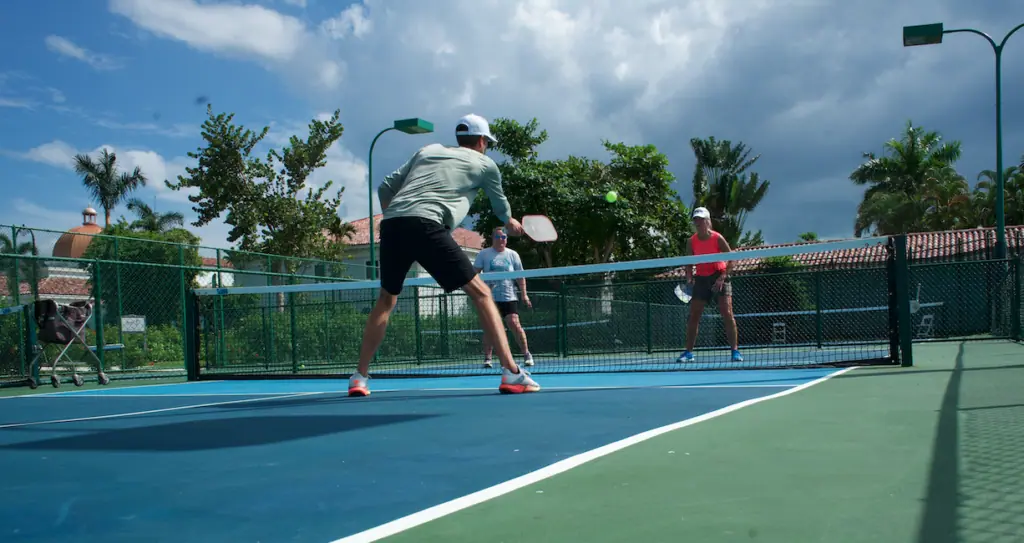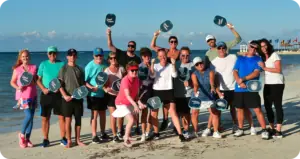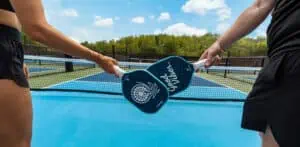Pickleball
What To Expect At Your First Pickleball Tournament: Tips for Beginners

If you’ve found yourself drawn to the fast-paced, fun-filled world of pickleball, you’re not alone! As pickleball continues to grow in popularity, more players are stepping onto the court for their very first tournament. While it can feel a bit overwhelming to dive into competition, remember that every pro was once a novice. Picture this: the thrill of serving your first ace, the camaraderie of sharing tips with fellow players, and the joy of celebrating little victories—all these moments make tournaments worthwhile. So, whether you’re lacing up your shoes for the first time or looking to sharpen your skills, this guide will walk you through what to expect at your first pickleball tournament and how to approach it like a champ!
At your first pickleball tournament, you can expect to experience a mix of excitement and nerves, as you’ll compete against players of varying skill levels. It’s essential to familiarize yourself with the tournament format and schedule while preparing adequately through practice and mental visualization techniques; this will help you feel more confident and ready for the competition. Additionally, be prepared for camaraderie among participants and focus on enjoying the game, regardless of your performance.
Getting Ready for Your First Tournament
Preparing for a pickleball tournament goes beyond just practicing your serve. It involves a thoughtful approach to both physical and mental fitness. Start by scheduling regular practice sessions two to three weeks before the event. This time investment lays a solid foundation so you’ll arrive confident and ready.
Regularly hitting the courts will help sharpen your skills, build your stamina, and familiarize you with game situations. Consider incorporating mixed drills and mock matches with friends, as one amateur player shared; this experience can replicate the competitive environment you’ll face during the tournament.
After ensuring you’re physically prepared, let’s talk about maintaining optimal condition in the days leading up to your matches.
Physical and Mental Preparation
The week before the tournament is crucial for both hydration and nutrition. Making sure you are properly hydrated and consuming balanced meals maintains peak physical condition. Hydration isn’t just about drinking water; it’s also beneficial to eat foods with high water content like fruits and vegetables. Nutrient-rich foods packed with protein and healthy carbs can significantly boost your energy levels, making those critical points more manageable.
Mentally preparing is just as important as the physical aspect. Visualizing successful plays is an excellent technique; it allows you to mentally rehearse what you plan to execute in your matches. According to a 2024 survey by the Pickleball Association, 72% of players reported increased performance through mental visualization techniques. Imagining yourself successfully executing shots or strategizing against opponents can bolster your confidence when it’s time to compete.
In addition to physical and mental preparation, understanding the rules of pickleball is a fundamental part of being tournament-ready.
Know the Rules Inside Out
Familiarize yourself with the official pickleball rules. Harvesting knowledge on scoring, service faults, and line calls that vary slightly from casual play could make a significant difference in your performance on match day. Understanding these nuances helps you feel secure in your gameplay and decision-making.
For instance, knowing how to challenge a call confidently can turn around a tight match in your favor. An umpire once advised that clarity in rules equips players with tools not just for winning games but also for enhancing overall enjoyment of the sport. Mastering these details not only prepares you for the match itself but also adds to your confidence while playing.
With practice behind you and knowledge of the rules at hand, you’re setting yourself up for success as you transition into gathering the essential equipment needed for a smooth experience on match day.
Essential Gear and Equipment
The right gear can significantly elevate your performance and comfort during a tournament. It’s crucial to think about what will best support your play style and ensure you perform at your best. One of the most notable recommendations is to invest in high-quality paddles from trusted brands like Onix or Selkirk, praised for their durability and precision. Having a suitable paddle can make all the difference in executing those tricky shots that can turn the tide of a game.
Must-Have Items
When it comes to equipment, certain items are non-negotiable if you want to compete effectively.
- Paddle: When selecting a paddle, look for options that strike the perfect balance between weight and sturdiness. A lightweight paddle allows for quick maneuverability, but sturdiness ensures it can withstand the rigors of competitive play. Tailor your choice to your specific playing style—whether you prioritize control with softer shots or prefer more power for aggressive play.
- Shoes: It’s essential to opt for court-specific shoes. These shoes provide excellent grip on the court surface, which enhances your footing during fast-paced matches, minimizing the chance of slips and falls. Additionally, seeking shoes designed with proper ankle support can prevent injuries. The last thing you want during an intense match is a twisted ankle.
- Apparel: Your choice of clothing shouldn’t be overlooked either. Wearing moisture-wicking clothes helps keep you cool and dry through sweat-intensive matches, allowing for greater focus on your performance rather than discomfort. Consider picking clothes that allow free movement; comfort speaks volumes in performance.
- Accessories: Lastly, consider packing some accessories like a sweatband to keep perspiration out of your eyes and sunglasses to shield against glare when playing outdoors, and don’t forget an extra water bottle! Staying hydrated is key to maintaining energy levels throughout the tournament.
A seasoned player once shared that switching to a pro-grade paddle improved his game by 15%, particularly enhancing his control and spin. This anecdote underscores how the right equipment is not just about personal preference; it’s also about potential gains in performance.
By equipping yourself with the essentials and gearing up appropriately, you put yourself on the right path for success as you approach the critical aspects of your upcoming event. Let’s shift our focus now to explore important procedures that lay the groundwork for effective participation.
Registration and Warm-Up
Completing registration can feel like a whirlwind, especially if it’s your first tournament, but remember, this is just the beginning of a rewarding experience.
It’s essential to arrive early, not just to handle any paperwork but to absorb the surroundings and mentally transition into “tournament mode.” As you check in, take a moment to survey the atmosphere—breathe in the competitive spirit and let it motivate you. During this time, ensure you have everything in order: your player number, any necessary waivers signed, and, of course, your gear ready to go.
Once you’ve registered, make networking a priority. Chat with fellow competitors; many are eager to share tips or reminisce about their own early experiences. This interaction helps build rapport and ease tension as you collectively prepare for what’s ahead.
Warm-Up Routine
Transitioning from registration to warm-up should be seamless. Start with light jogging around the court area. This isn’t just to break a sweat; it gets your heart pumping and muscles warmed up for the action ahead.
As you jog, pay attention to how the court feels underfoot—this will save you potential slips during play. After a few laps, incorporate dynamic stretching, focusing on your arms and legs. Aim for gentle lunges and arm circles to get your joints lubricated and nimble.
Next comes shadow practice—a critical exercise where you mimic serving and volleying without a ball. This mental rehearsal is fantastic for muscle memory; it keeps you focused on technique without the added pressure of competition. Visualize hitting that perfect serve or executing a flawless volley while staying loose.
Finally, engage in light practice games with fellow participants. These warm-up matches allow you to get used to playing at tournament intensity while still working out any last-minute nerves in a supportive environment. For instance, one previous participant discovered that engaging in even just 20 minutes of practice significantly reduced his jitters before his first official game.
Connecting with other players during warm-up can enhance both skills and camaraderie.
As you wind down your warm-up session, take a moment to gather your thoughts. Remind yourself of the skills you’ve practiced leading up to this tournament. Visualize your strategy for your upcoming matches—this psychological preparation can be just as crucial as physical readiness.
With preparations underway and confidence building, you’ll be ready to tackle the challenges that await on the court.
Navigating Match Dynamics
Understanding match dynamics is a game-changer when it comes to maximizing your performance against various opponents. It’s not just about your skills; it’s about leveraging those against your opponent’s weaknesses. Start by paying close attention to the draw sheet, allowing you to identify who you might face in subsequent rounds. Watching other players’ matches is essential—it’s a bit like playing detective. You’re looking for patterns that reveal how they react under pressure.
Reading Your Opponent
When you’re watching potential opponents, focus on three main aspects of their gameplay. First, you want to identify if they are forehand or backhand dominant, which can make a significant difference in strategy. A player with a strong forehand might be less confident making consistent shots with their backhand, leaving room for targeted plays.
Next, observe their reaction times and footwork. Are they quick to the ball, or do they hesitate? This insight can inform your own approach to rallying the ball effectively.
Understanding these dynamics isn’t just about observing; it also means adjusting your strategy mid-game.
Once you’ve identified an opponent’s weaknesses, such as a less dominant backhand or slower footwork, it’s time to adjust your shots accordingly. You don’t have to change everything at once, but focusing on their weaker side can increase your chances of winning critical points. This strategic use of your awareness has the potential to turn the tide in tightly contested matches.
Some people debate whether mind games play a pivotal role in matches—do the psychological aspects weigh just as much as skill? In many ways, yes! Engaging mentally with your opponent can give you an edge. Think of it like chess: studying your opponent’s tendencies helps you anticipate their moves while remaining ready for anything unexpected.
As you embark on this engaging journey of competition, each match presents an opportunity for growth and learning. This competition isn’t merely about winning but embracing the camaraderie and rich experiences shared with fellow players. Stay adaptable and keep having fun with the game!
With these insights into match dynamics, we can now explore effective approaches that shape competitive gameplay.
Strategies for Competitive Play
When stepping onto the pickleball court, it’s essential to remember that tactical play transcends just putting the ball over the net; it’s about creating opportunities and capitalizing on them. Incorporating strategies such as spin serves and aggressive net play can shift the momentum in your favor, unsettling your opponents and giving you a competitive edge. Take, for instance, a player who invested time mastering the spin serve and subsequently advanced two rounds simply by exploiting their opponent’s struggles with this technique.
Tactical Moves
One effective strategy is to employ angled volleys. By doing so, you can keep your opponents constantly moving, forcing them to adjust their position with each shot. This disrupts their flow and opens up space for potential winning shots. Imagine setting up for a volley: instead of swinging straight across the net, direct your shot towards the far corner—this could catch your opponent off guard and give you the upper hand.
Another tactic involves varying your serve speeds. Different serving speeds can disrupt your opponent’s rhythm during the game. For example, alternating between fast-paced serves and slower, more deliberate ones forces your opponent to adapt continually, which can lead to mistakes. Picture the confusion on their face when they expect a quick serve but receive a gentle lob instead!
Utilizing drop shots is another clever move to keep your adversaries guessing. When they anticipate powerful drives toward the back of the court, surprising them with a finely placed drop shot can yield great results. These quick adjustments keep your opponents on their toes and competing against not just your skills but also your strategic mindset.
Communication and Coordination
While tactical play significantly enhances your competitiveness, communication with your partner is crucial during doubles matches. Establish clear signals for intended shots or plays before stepping onto the court; words like “Mine!” or “Switch!” will reduce any confusion and foster better teamwork throughout your match. The synergy created through effective communication ensures you’re both on the same page when executing these tactical moves.
As you prepare for tournaments, focus on minimizing unforced errors by practicing these strategies consistently during scrimmages. Teams that concentrate on preventing faults often perform better overall because they maintain control over each point played. Therefore, devote time to practicing placement over power; make every shot count—not as a desperate attempt to overpower an opponent but rather as a strategic decision aimed at securing victory.
By mastering these strategies and enhancing communication with your partner, you’ll be well-positioned to navigate challenges effectively and further enrich your gameplay experience ahead.
Enhancing Your Tournament Experience
It’s essential to remember that a pickleball tournament is more than just a series of matches; it’s an opportunity to grow as a player and build connections within the community. Engaging with fellow participants can truly elevate your experience.
Sharing stories, strategies, and laughter fosters a sense of camaraderie that many newcomers find rewarding. You might discover that some of your best memories come from those impromptu conversations during breaks or at social gatherings organized by the tournament.
Be proactive in connecting with others. Don’t hesitate to introduce yourself to someone standing next to you on the sidelines or strike up a conversation during warm-ups. Many tournaments offer social events—these are perfect for mingling and learning from experienced players without the pressures of competition hanging over your head.
To take full advantage of all that the tournament has to offer, participating in workshops can greatly contribute to both your skill development and enjoyment.
Leveraging Your Time
One effective way to enhance your tournament experience is by attending player meetups. These gatherings allow less experienced players to gain insights and tips from those who have played at a higher level. Sharing knowledge helps in recognizing common mistakes or exploring different techniques. Moreover, it’s comforting to know that every player was once in your shoes, learning the ropes too.
Make it a point to visit any workshops offered during the tournament, especially those focused on advanced moves and strategies. Seasoned professionals often lead these sessions, providing tailored advice applicable to your play style. For instance, one participant mentioned how they discovered innovative footwork techniques at a clinic, which they quickly integrated into their game and saw instant improvement.
Additionally, integrating some downtime into your schedule is equally important. Balancing competition with relaxation allows you time to recharge mentally and physically. This might mean taking a stroll around the venue between matches or engaging in light-hearted games with fellow participants if space is available.
The key is not just pushing yourself through intense matches but also allowing moments where you can decompress and enjoy the atmosphere of the tournament setting.
Lastly, don’t overlook how blending competitive play with leisure can turn your tournament into a mini-vacation experience.
To weave these tournament experiences into a complete getaway, consider our specialized pickleball vacation packages at VibeGetaways. Combining competitive play with relaxation and new friendships makes for an unforgettable experience.
As you prepare for your first pickleball tournament, remember that it’s about enhancing skills while enjoying the journey. Explore our services at VibeGetaways or call us at 262-891-4768 for any assistance in planning your perfect trip!
More Articles
Pickleball: The Perfect Family Vacation Activity for Outdoor Fun and Bonding
Looking for a fun way to get the whole family outside and active on your next vacation? Pickleball might be…
Read MorePickleball History and Popularity: From Backyard Roots to a Global Sport
Pickleball started as a simple way for friends and family to have fun together, but today it’s become much more…
Read MoreVacation Planning Tips & Tricks: Your Ultimate Holiday Checklist for 2025
Planning a vacation might seem as simple as booking a flight and packing a bag, but anyone who’s ever felt…
Read More5 Secrets to Stress-Free Vacation Planning: The Ultimate Guide to Easy Travel
Planning a vacation should be exciting, not stressful, but all too often it feels like a juggling act, with flights,…
Read More


